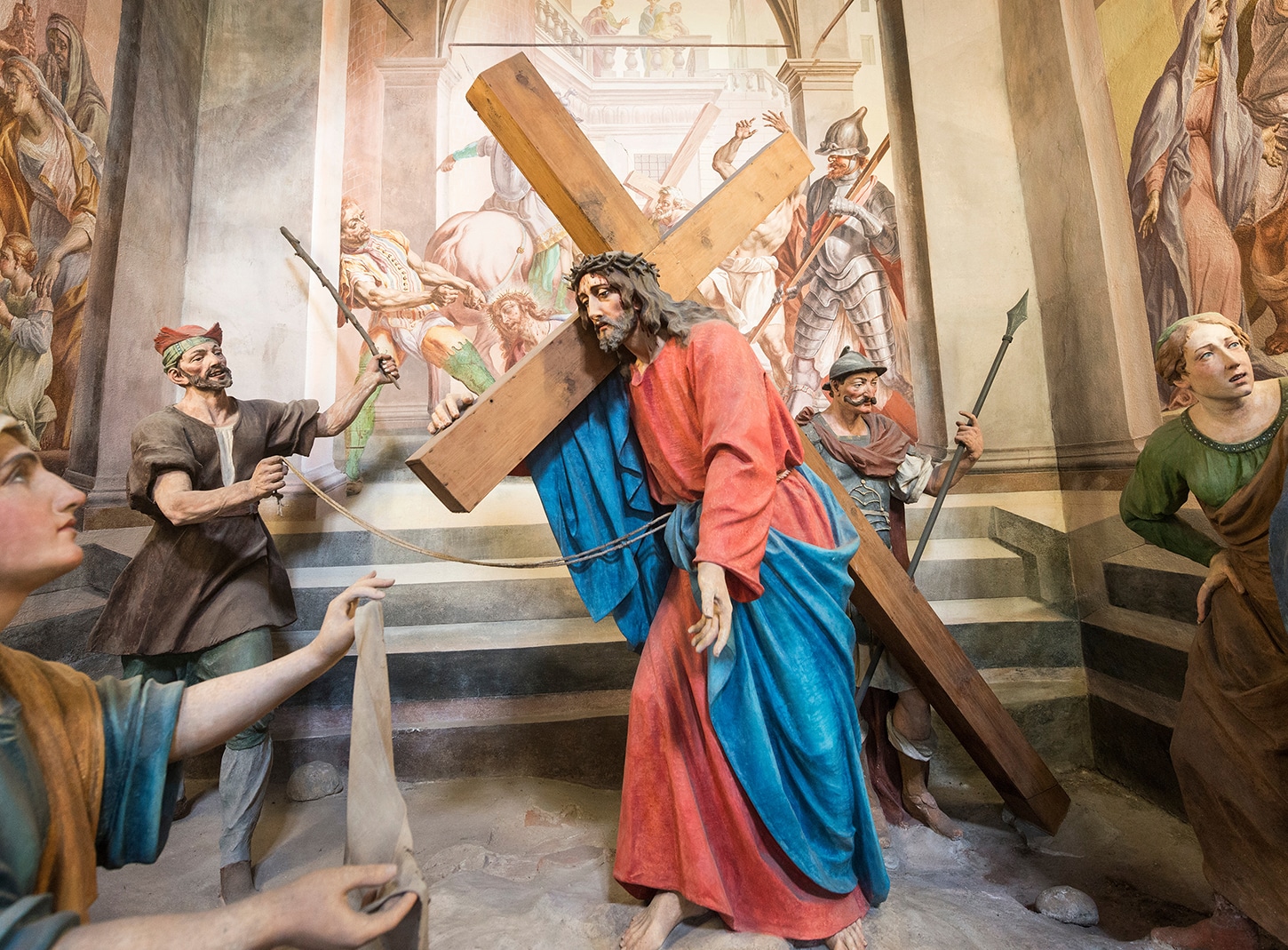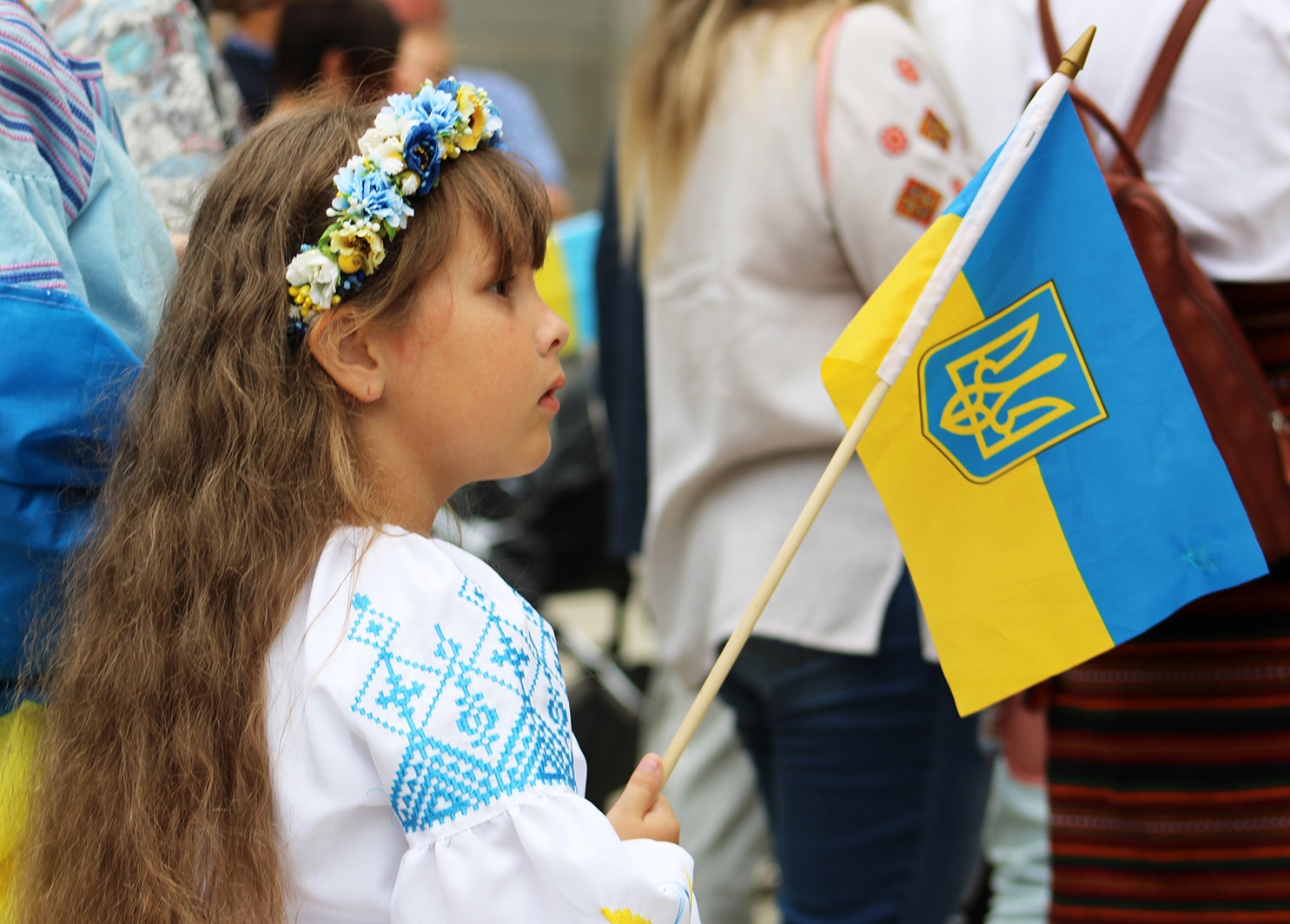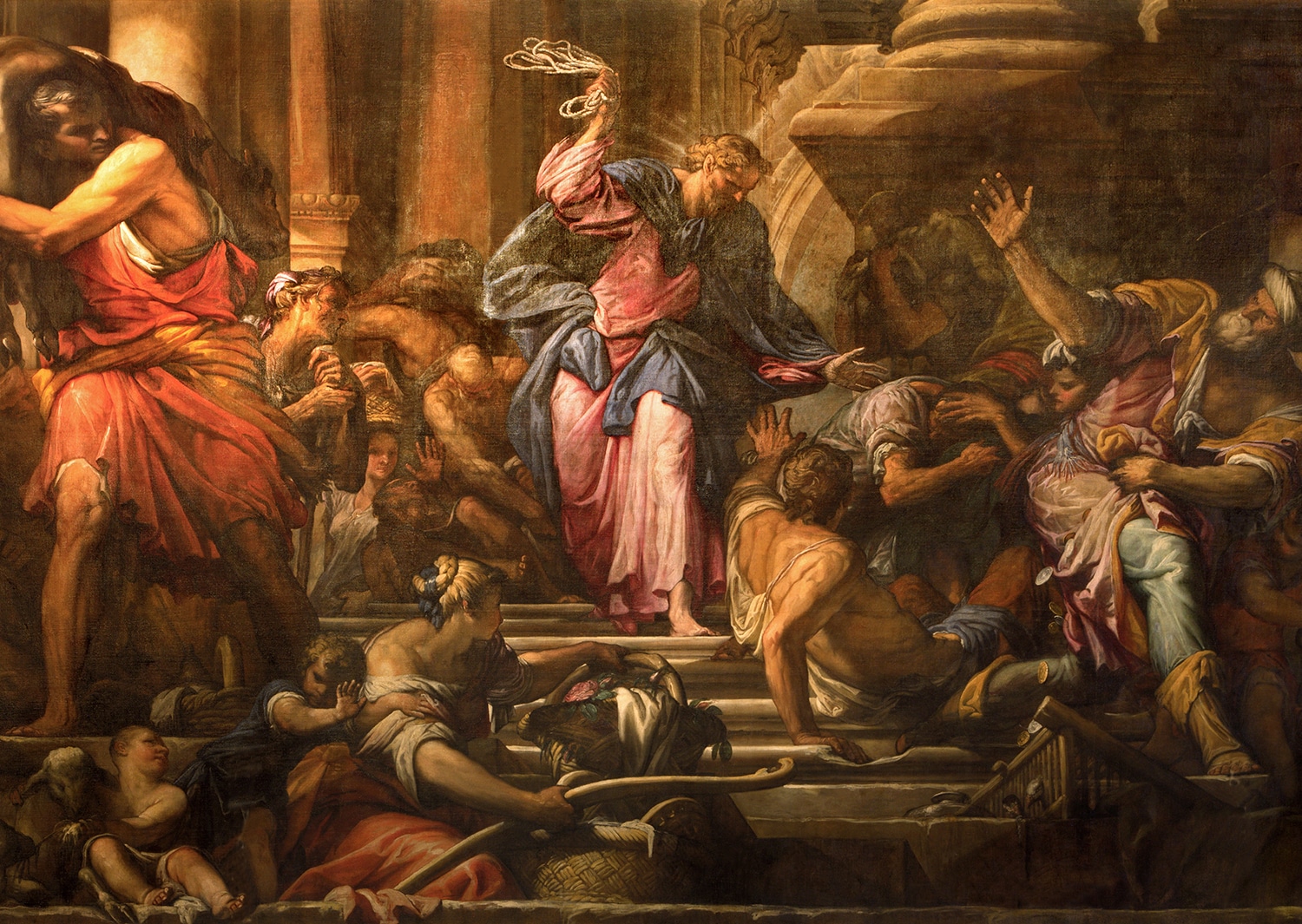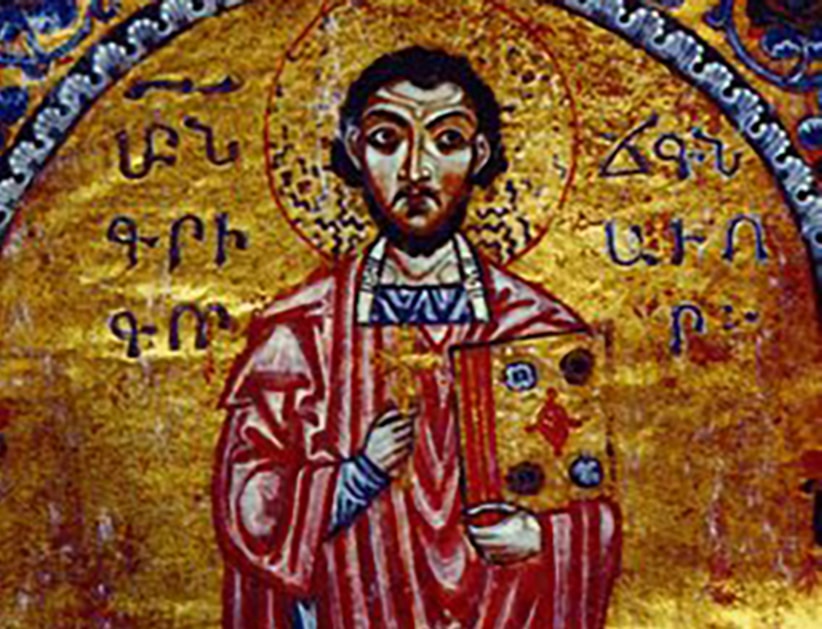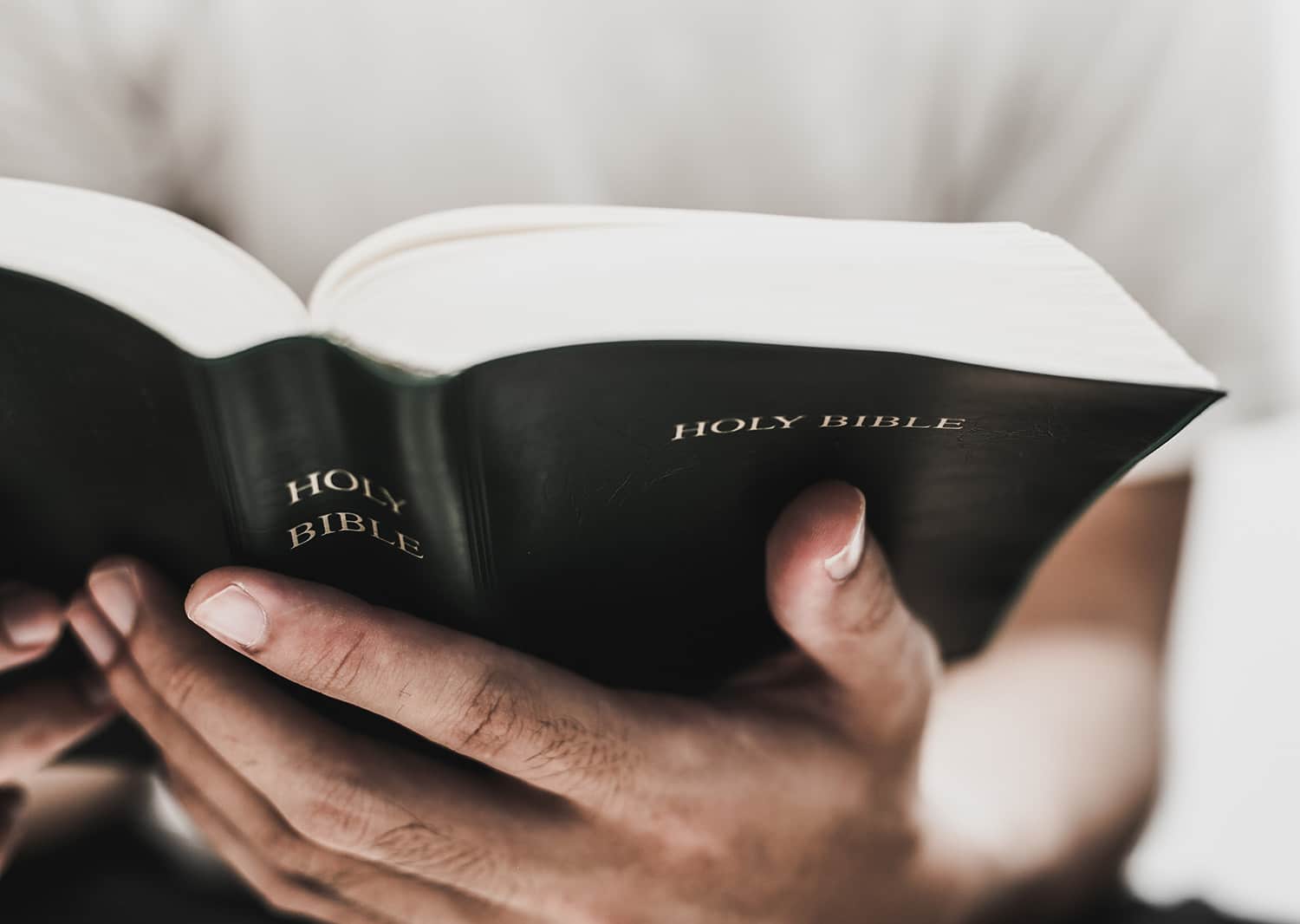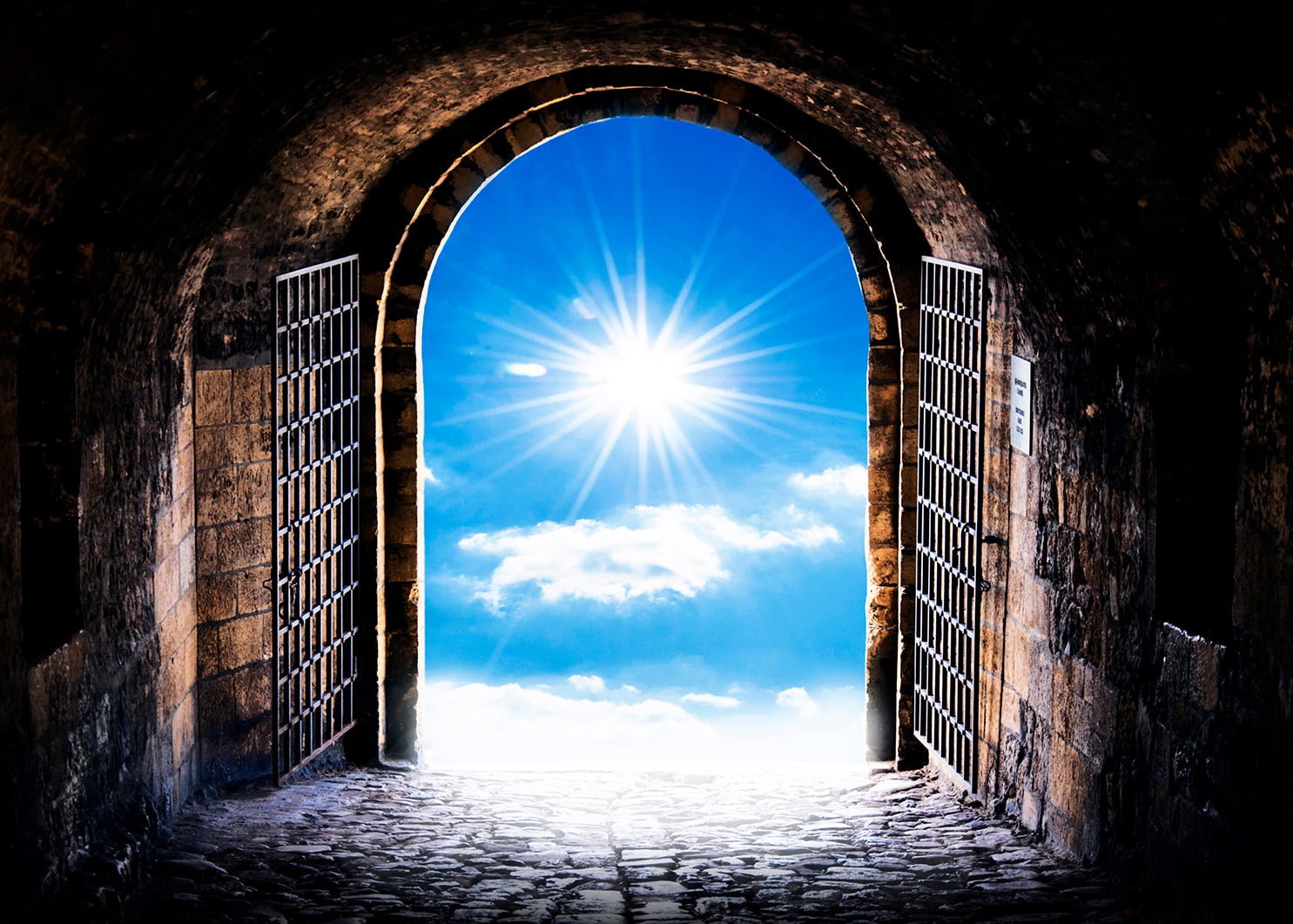Do you want to know and love God? The medieval Dominican mystic St. Catherine of Siena says that there is no better means than prayer. “For by such prayer the soul is united with God, following in the footsteps of Christ crucified, and through desire and affection and the union of love he makes of her another himself,” she explains.
We retrace Our Lord’s final steps in praying the Stations of the Cross. But this prayer is more than a casual recollection. Through the stations, we can know a tremendous and intimate union with him. Dominican Father A.G. Sertillanges says, “We can make our own the sphere of vision and the emotions that were his, seeing with his eyes and feeling with his heart, remembering, judging, and foreseeing with him, so that, still in this same sense of imagining that we have changed places with him, it is no longer we who live, but Christ who lives in us.”
The Stations of the Cross help us to better understand the Eucharistic mystery. In praying them, may we come to love Jesus all the more, and run to him, who is truly present in the sacrament of his body and blood.
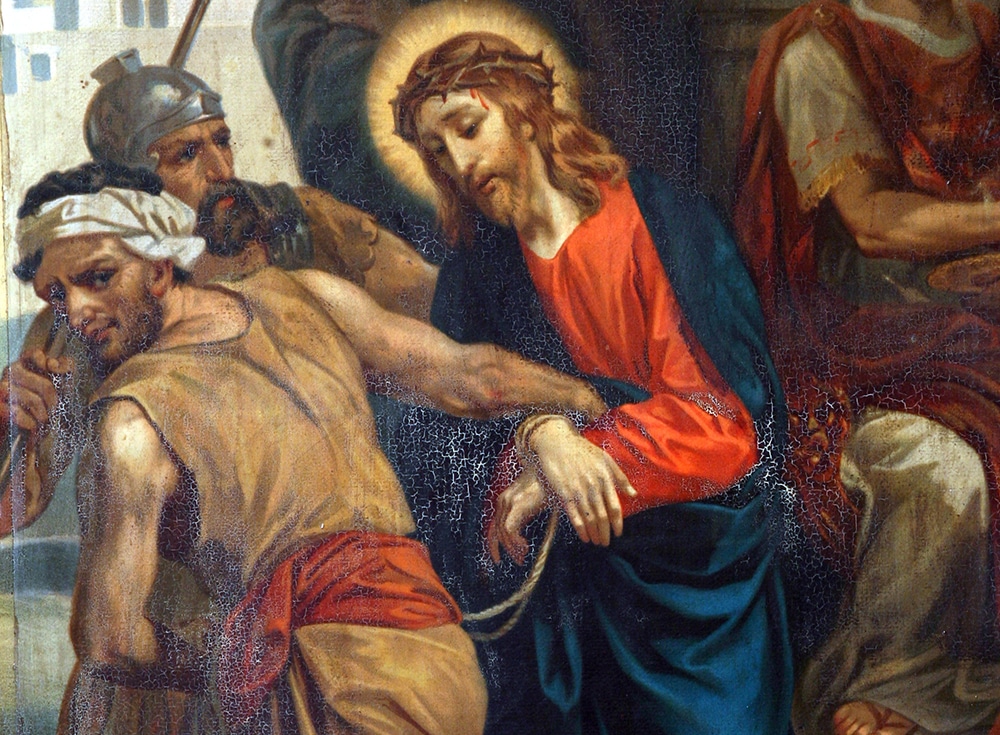
First Station: Jesus is condemned to death
R. We adore you, O Christ, and we praise you. (Genuflect)
V. Because by your holy cross you have redeemed the world.
“So Jesus came out, wearing the crown of thorns and the purple cloak. And [Pilate] said to them, ‘Behold, the man!'” (Jn 19:5).
Jesus is condemned and powerless in the eyes of the world. Beaten and scourged, he stands before Pilate, who questions him. A king? This man? Jesus is defenseless. There is no army attending him. Where is his kingdom? “Crucify him,” the crowd shouts. And Jesus does not turn away. He has never turned away from his mission to save those the Father has given him.
And this is the way of Jesus. He comes to us, making himself vulnerable. Behold, this is our king. He surrenders himself to the cross. It is always this way with love. It is fragile. Love means risking injury and scorn.
“Behold him who takes away the sins of the world,” says the priest at Mass as he holds the sacred host for all to see. In the Eucharist, Jesus comes before us again. We know it’s him. Faith allows us to see our king.
He is defenseless. He is vulnerable in that sacred host. He has handed over his life for us.
It is the way of love.
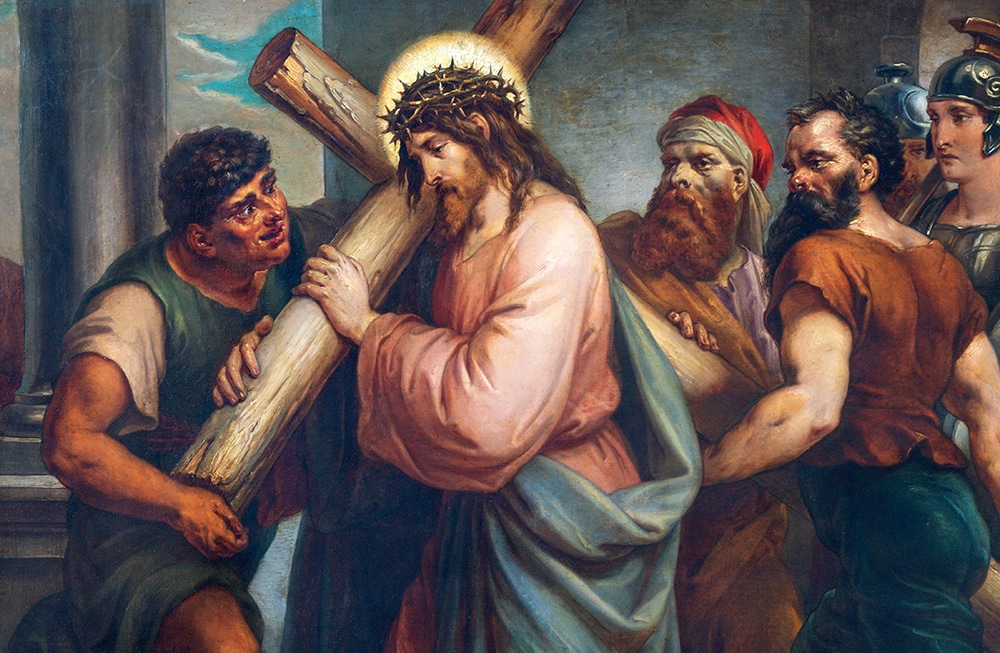
Second Station: Jesus carries the cross
R. We adore you, O Christ, and we praise you. (Genuflect)
V. Because by your holy cross you have redeemed the world.
“Carrying the cross himself he went out to what is called the Place of the Skull” (Jn 19:17).
He stooped under its weight. The mast of death had been thrust upon him. It was a burden too heavy for any other man.
But it was not his. It was ours.
“Bear one another’s burdens” his life preached. How he often bent to lift the weight of sin! To bring calm to the stormy seas of our hearts. To bestow a healing grace. To forgive.
Those same graces come in the Eucharist. It is the very food of mercy. It renews and strengthens. And because we have the Eucharist, we can struggle on through this world of sin.
His cross? It was ours. But only Jesus could manage its weight. And because he carried that cross, no cross that comes our way is too great.
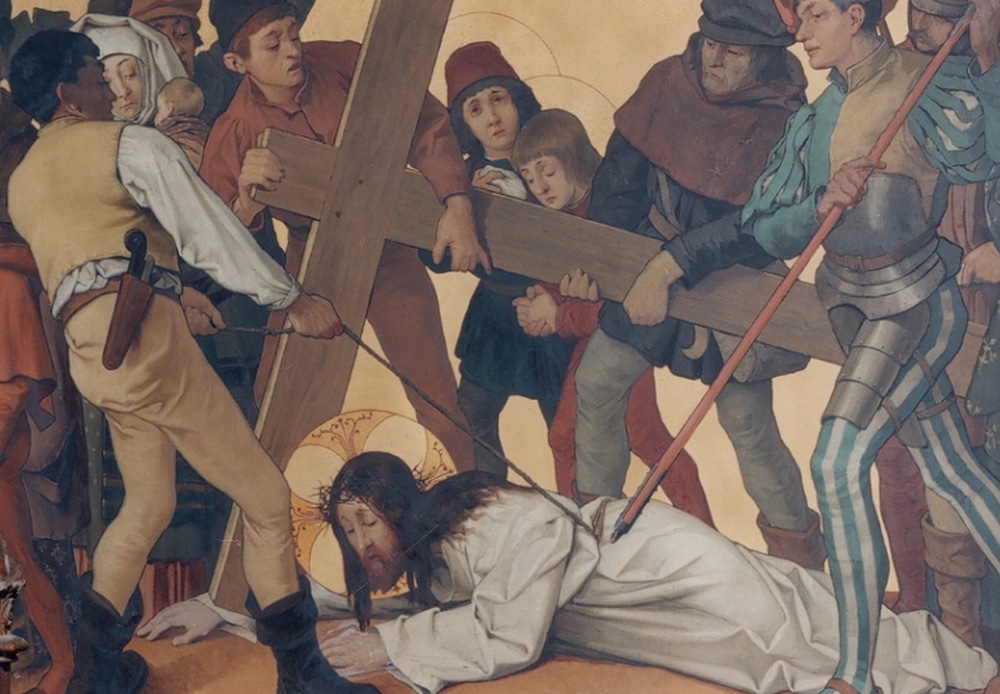
Third Station: Jesus falls for the first time
R. We adore you, O Christ, and we praise you. (Genuflect)
V. Because by your holy cross you have redeemed the world.
“Amen, amen, I say to you, unless a grain of wheat falls to the ground and dies, it remains just a grain of wheat; but if it dies, it produces much fruit” (Jn 12:24)
Beaten and weary, he stumbles. He falls. The cross tumbles down, pressing his precious body to the earth. But there was another fall. There was a fall before this one. The very reason that we need a redeemer is the fall of Eden, the fall in the garden when our first parents fell from grace.
The grain falls to the ground. Jesus, too, falls. In the order of nature, a seed falls to the ground and dies so that it might bear fruit. The seed’s demise leads to the harvest. And to redeem us, Jesus falls to the ground and gives his life that we might have life abundantly. Our Lord has won for us the ultimate harvest.
The Eucharist is the food of our redemption, the fruit of the seed that has fallen to the ground and died.
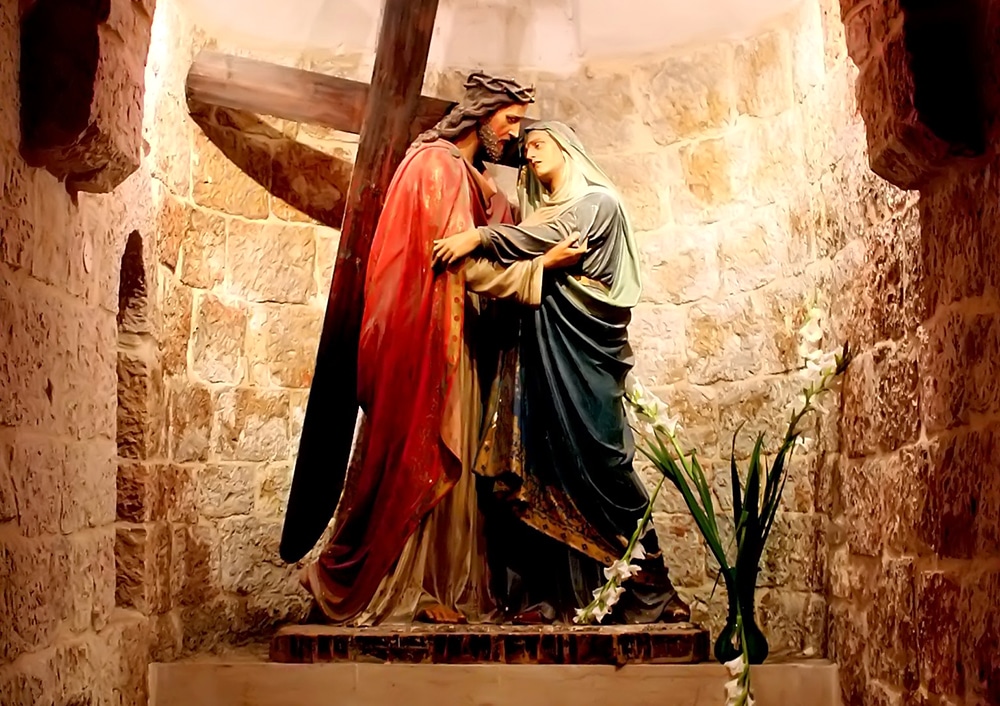
Fourth Station: Jesus meets his mother
R. We adore you, O Christ, and we praise you. (Genuflect)
V. Because by your holy cross you have redeemed the world.
“(And you yourself a sword will pierce) so that the thoughts of many hearts may be revealed” (Lk 2:35).
She was the first to follow him. And on the way to the cross, she follows him still.
Does Mary speak as she looks upon her son? How many times did she gaze upon his holy face? And now she sees her beloved son carrying a cross, condemned to die.
Her heart is crushed by sorrow, pierced as Simeon prophesied. And yet she accepts the unfolding tragedy with a strength that silences any cry of protest.
The Virgin Mary and her son are inseparable. After his death, what was her consolation? The Eucharist. She was the first tabernacle, the first to have borne his holy body, and in the Eucharist, she remained united to him.
Her mother’s heart anguished. How she must have wept! But mother and son both know the Father’s will. His pain was hers. His suffering was hers. And his love was hers. That same love is veiled in the gift of the tiny host.
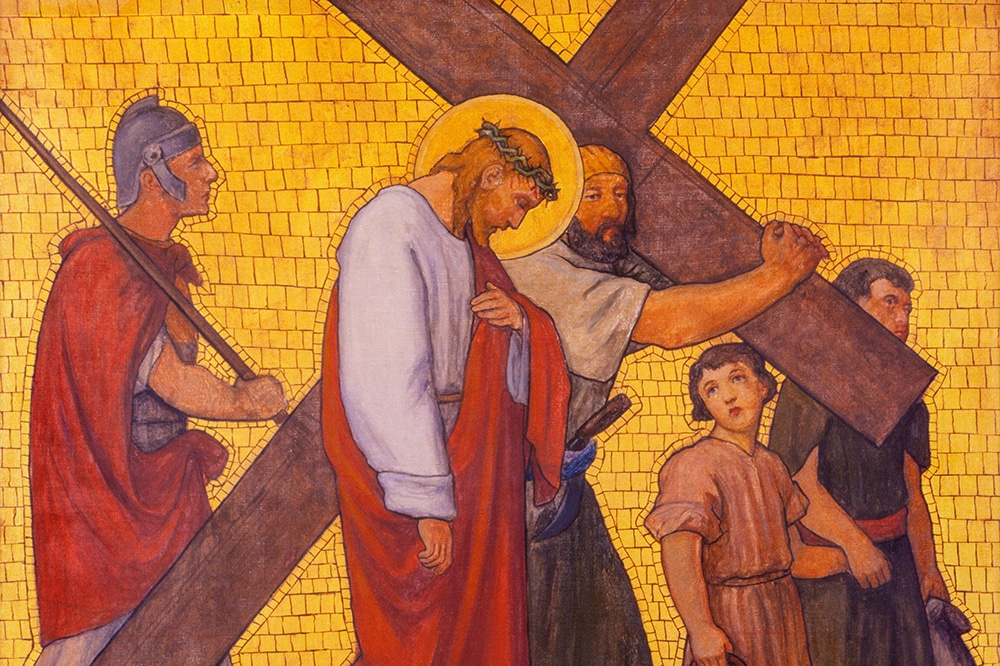
Fifth Station: Simon helps Jesus carry the cross
R. We adore you, O Christ, and we praise you. (Genuflect)
V. Because by your holy cross you have redeemed the world.
“As they were going out, they met a Cyrenian named Simon; this man they pressed into service to carry his cross” (Mt 27:32).
Everyone can see that the cross is too much for him to carry on his own. He has already fallen once. Who will step in to help Jesus? No one steps forward willingly.
Soldiers grab Simon of Cyrene and force him to help Jesus carry the cross. He could have carried it on his own. God could have arranged things otherwise. But in his wisdom, it was ordained that Simon would help Jesus.
All of us are called to be servants, to bear Jesus, to carry the cross into the world. What better service is there than to live in service to the Blessed Sacrament? Christ dwells in us! Every Christian, through Baptism, is claimed for Christ and committed to this mission.
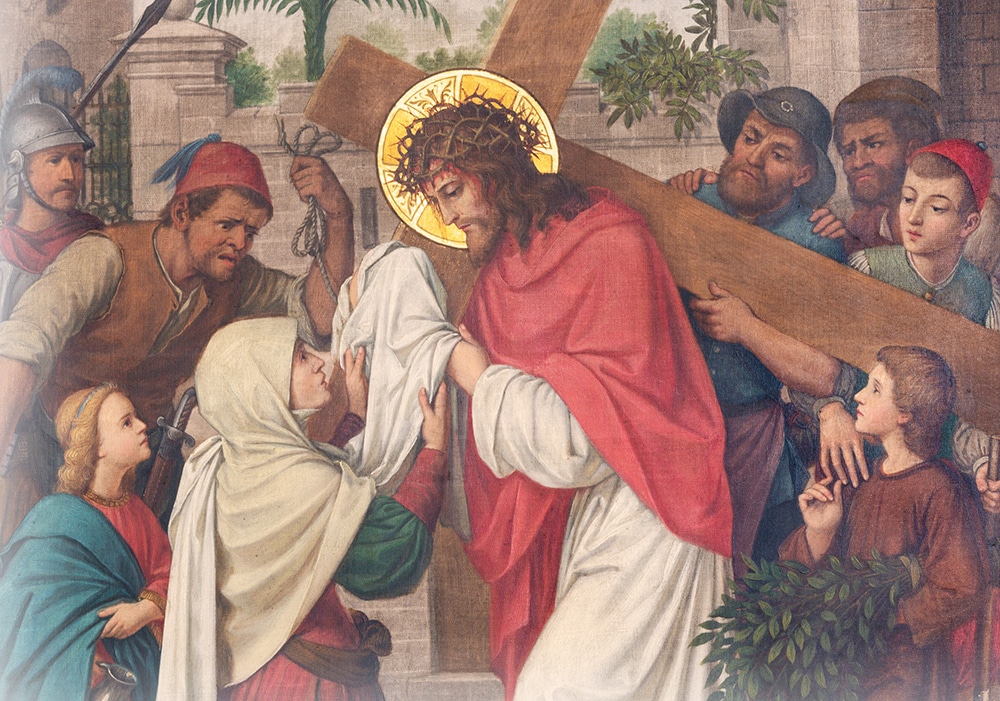
Sixth Station: Veronica wipes the face of Jesus
R. We adore you, O Christ, and we praise you. (Genuflect)
V. Because by your holy cross you have redeemed the world.
“He was spurned and avoided by men, a man of suffering, knowing pain, Like one from whom you turn your face, spurned, and we held him in no esteem” (Is 53:3).
Joseph and Mary gazed with wonder upon his face in Bethlehem. The woman at the well discovered the truth when she looked into his eyes. Zaccheus climbed a tree to glimpse him. His closest disciples marveled when they beheld the glory of his face on Mount Tabor.
And now? His face, bruised and raw, is a pitiful sight. Veronica runs to wipe his blood-stained brow. And his face leaves an image on her holy veil.
The Eucharist builds up that image of Christ in us. People should look upon us and see him. We are called to be other Christs, and by the grace given in the holy sacrament, it is made so. The veil is a true image, a true icon. But a greater icon still is the heart conformed in love to him.
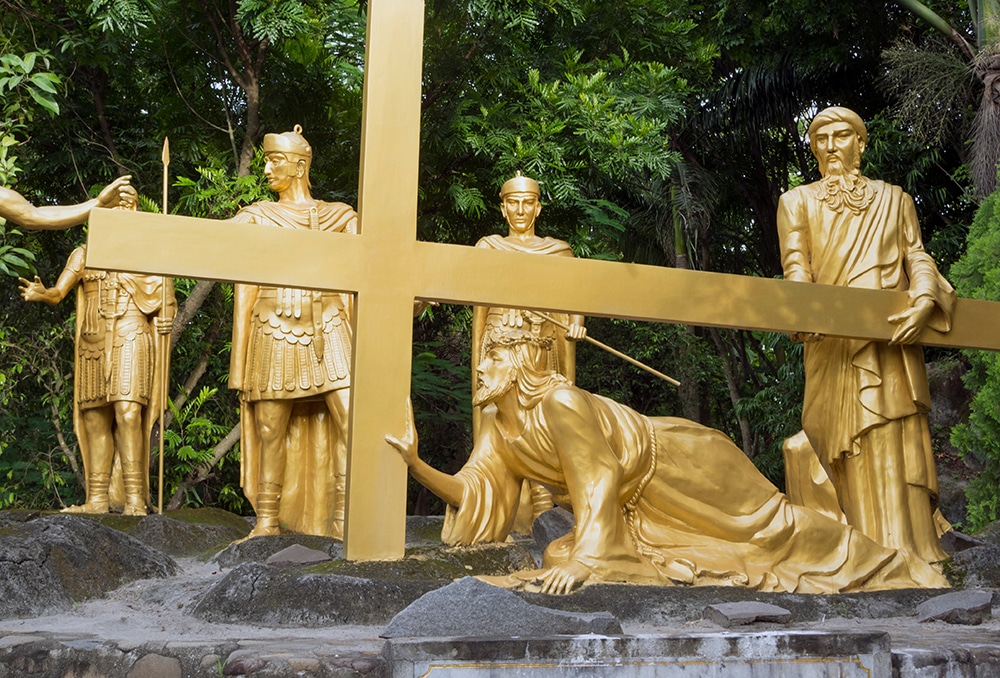
Seventh Station: Jesus falls the second time
R. We adore you, O Christ, and we praise you. (Genuflect)
V. Because by your holy cross you have redeemed the world.
“He emptied himself, taking the form of a slave, coming in human likeness; and found human in appearance, he humbled himself, becoming obedient to death, even death on a cross” (Phil 2:7-8).
Our Lenten pilgrimage begins in dust. “Remember that you are dust, and to dust you shall return,” we pray during the distribution of ashes. And now, Jesus falls again. The cross topples over. Simon jumps away. Our Lord lies face down, his cheek against the dust. The Word who created the earth meets it again.
Before all the world was made, the Son rejoiced in communion with the Father and the Holy Spirit. “All things came to be through him” (Jn 1:3). The same Son agreed to the Father’s plan to enter that creation. So low has he stooped that his face now rests against the sand and stone.
And even that was not close enough. In his lowliness, he consents to come to us in the form of bread and wine. His true nature hidden from our senses, the Lord empties himself still. He comes to us in all humility in the holy Eucharist.
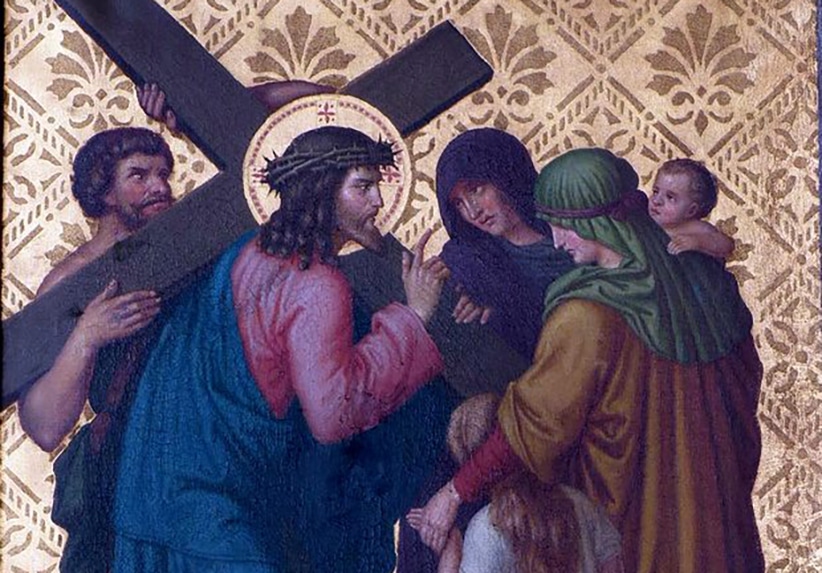
Eighth Station: Jesus meets the women of Jerusalem
R. We adore you, O Christ, and we praise you. (Genuflect)
V. Because by your holy cross you have redeemed the world.
“A large crowd of people followed Jesus, including many women who mourned and lamented him. Jesus turned to them and said, ‘Daughters of Jerusalem, do not weep for me; weep instead for yourselves and for your children'” (Lk 23:27-28).
Jesus embraces his mother. He accepts Simon’s help. He allows Veronica to wipe the sweat and blood from his face. But when he encounters his friends who weep for him, he refuses their compassion. “Do not weep for me,” he commands.
But is that all there is? Weep for yourselves, he says, for your children. What could this mean?
In these words Jesus warns the holy women that the cross will come to their hearts too. Evil and suffering will come again and again. We must weep then for ourselves and those we love that we might embrace the cross when it comes. We must weep for our sins and seek forgiveness and conversion.
The Eucharist brings about sorrow for our sins. We should then run to the confessional, cleanse our hearts, and, having confessed, be ready to receive Our Lord.
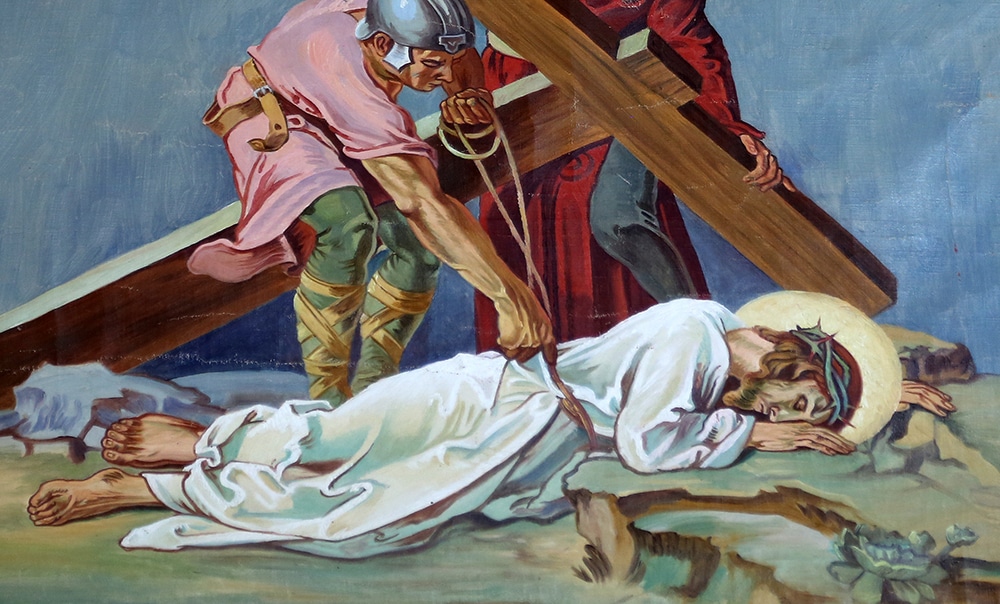
Ninth Station: Jesus falls the third time
R. We adore you, O Christ, and we praise you. (Genuflect)
V. Because by your holy cross you have redeemed the world.
“I live, no longer I, but Christ lives in me; insofar as I now live in the flesh, I live by faith in the Son of God who has loved me and given himself up for me” (Gal 2:20).
Jesus is now well beyond the walls of the Holy City. He climbs Golgotha, the hill where he will breathe his last. A crowd has gathered, following Jesus from the moment Pilate handed him over. Each step brings him closer to the place of execution. He stumbles on the uneven path. He falls one last time.
Why three falls? Our minds recall the three temptations Jesus faced in the wilderness. The devil’s allure offered power and pleasure. And three times Jesus overcomes his seduction. Three times Our Lord stands up again, rising to overcome defeat.
We are always tempted to disbelieve Jesus’ words. He has told us the Eucharist is his own very flesh. Again and again, we have to overcome the temptation to believe otherwise, to abandon him, to doubt what he has promised. Again and again we must rise, placing ourselves before him, professing our faith in this sacred mystery.
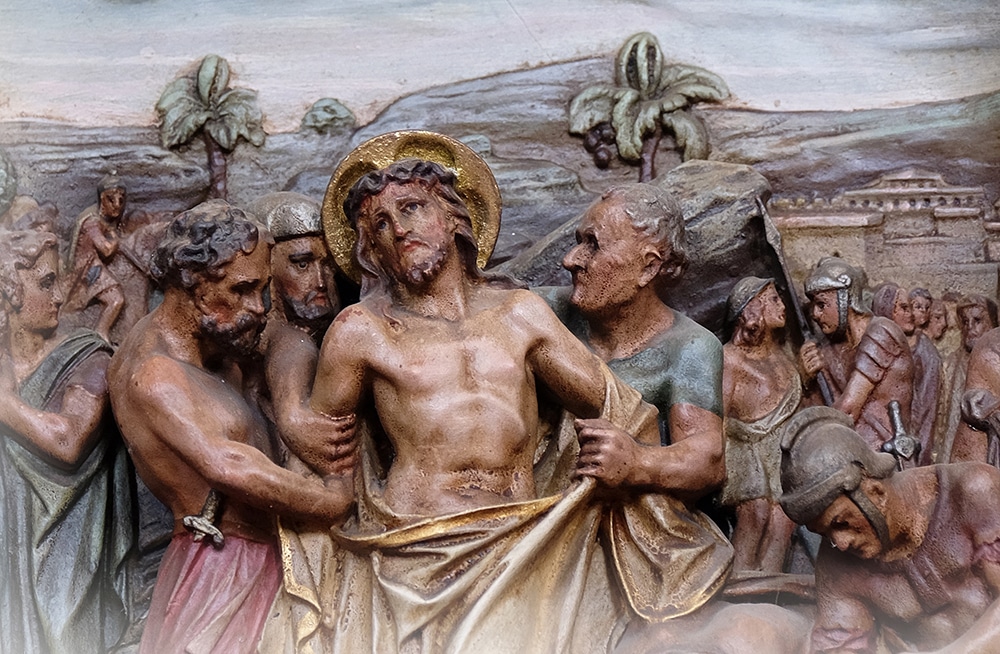
Tenth Station: Jesus is stripped of his garments
R. We adore you, O Christ, and we praise you. (Genuflect)
V. Because by your holy cross you have redeemed the world.
“When I am lifted up from the earth, I will draw everyone to myself” (Jn 12:32).
Having arrived at the place of the crucifixion, soldiers tore off his tunic. The wounds from his scourging were revealed to all. He stood bare and exposed before the murderous crowd.
How completely he identifies with us! He stands, naked, in solidarity with every sinner whose secret shame has been revealed.
Did the crowd jeer? Was he further mocked? Were any hearts moved with compassion?
In our day, we must ask, how often is the holy Eucharist stripped of its meaning? How often is Jesus neglected, ignored and profaned? How often does he stand before us in the sacred host, unprotected, uncovered, only to be forsaken?
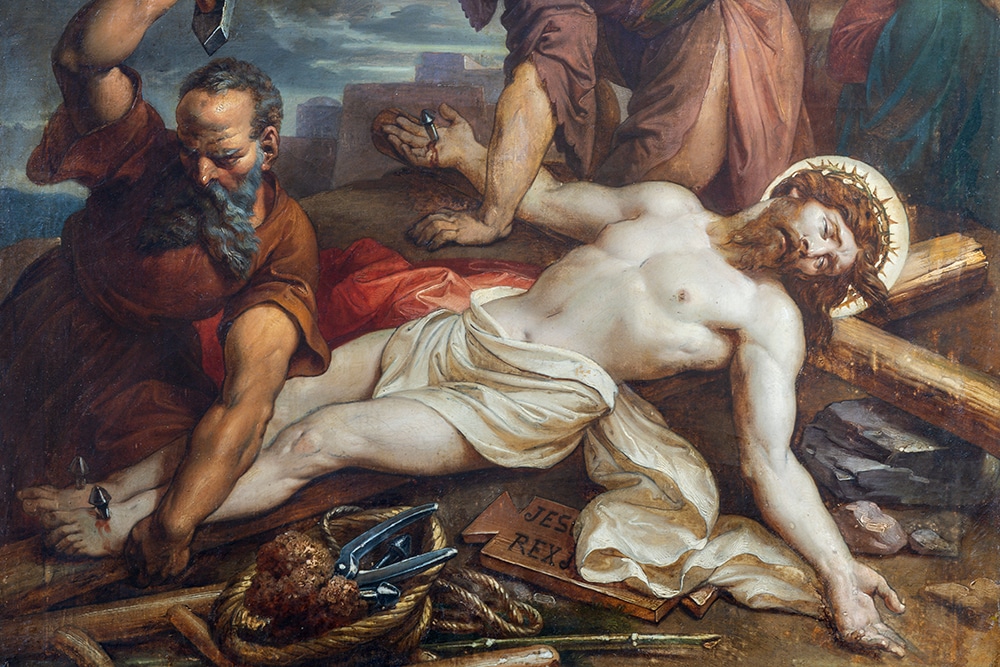
Eleventh Station: Jesus is nailed to the cross
R. We adore you, O Christ, and we praise you. (Genuflect)
V. Because by your holy cross you have redeemed the world.
“He himself bore our sins in his body upon the cross, so that, free from sin, we might live for righteousness. By his wounds you have been healed” (1 Pt 2:24).
His broken body is stretched over the great tree of Calvary. His extended arms, stretching to the ends of the earth, show the totality of his sacrifice.
How completely he gives of himself! He gives himself for every disciple, every convert who adopts his teaching, every sinner who comes to him.
“He saved others; he cannot save himself,” the crowds cried. But he had not come to save himself. He came to give of himself. This is the great meaning of the Eucharist, the gift of himself, poured out for us.
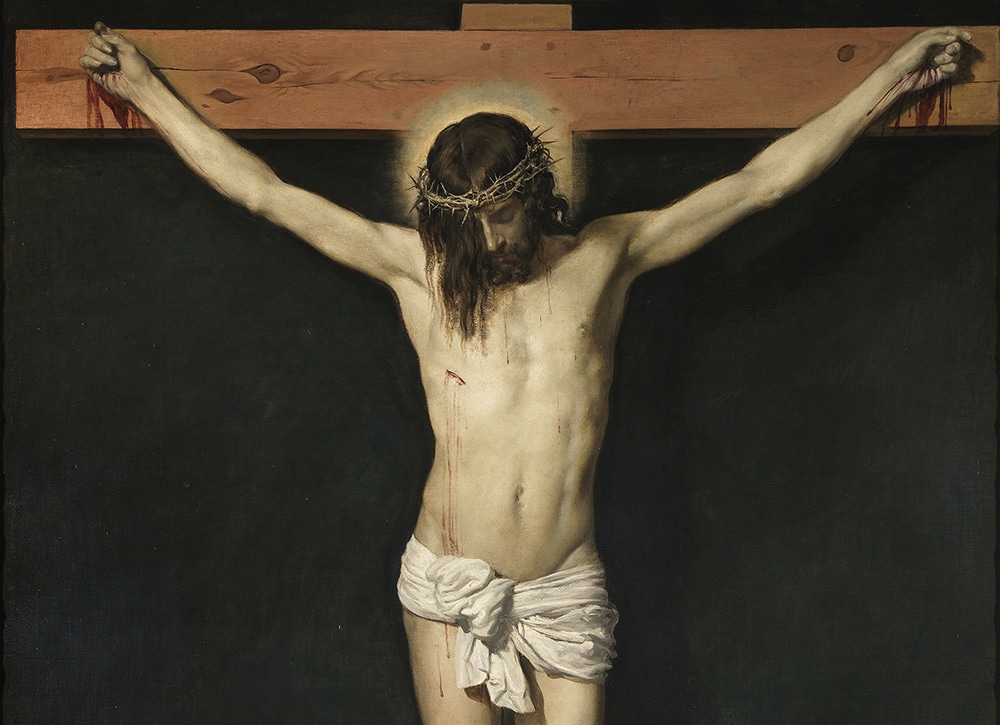
Twelfth Station: Jesus dies on the cross
R. We adore you, O Christ, and we praise you. (Genuflect)
V. Because by your holy cross you have redeemed the world.
“No one has greater love than this, to lay down one’s life for one’s friends” (Jn 15:13).
The time has come. The pivotal moment of history is, at last, upon all of humanity. The veil of the temple is rent. The earth trembles. Jesus cries out in a loud voice, “Father, into your hands I commend my spirit,” and Our Lord breathes his last.
It is not an hour of defeat. Just as it seems his plan of love has failed, the final workings have been accomplished. This is the sacrifice he had intended. This is the great moment of love!
In the Eucharist, we are there. We access the graces of Calvary. Sacramentally, we stand again at the foot of the cross when our great high priest is offered as the victim on the altar.
In his death, we have died to sin. Our every communion is union with him, the one who has died for us.
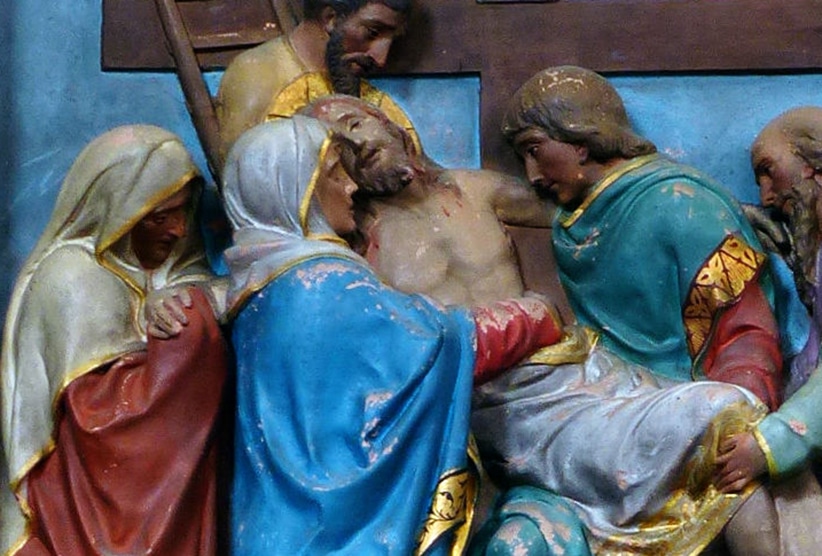
Thirteenth Station: Jesus is taken down from the cross
R. We adore you, O Christ, and we praise you. (Genuflect)
V. Because by your holy cross you have redeemed the world.
“After this, Joseph of Arimathea, secretly a disciple of Jesus for fear of the Jews, asked Pilate if he could remove the body of Jesus. And Pilate permitted it. So he came and took his body” (Jn 19:38).
He has given his life for us. And now his weary corpse, taken down from the cross by Joseph of Arimathea, is placed in the arms of his mother. How tenderly she must have received her son. She cradled him as a babe, now she holds him close once more.
Imagine how she wept and prayed over him. She held him for all of us, reverently, filled with love. And drawing him near, she draws us near, bringing us, through him, close to her heart.
In our communions, we, too, receive the body of Jesus. Do we receive him with the same love that his mother showed at the foot of the cross?
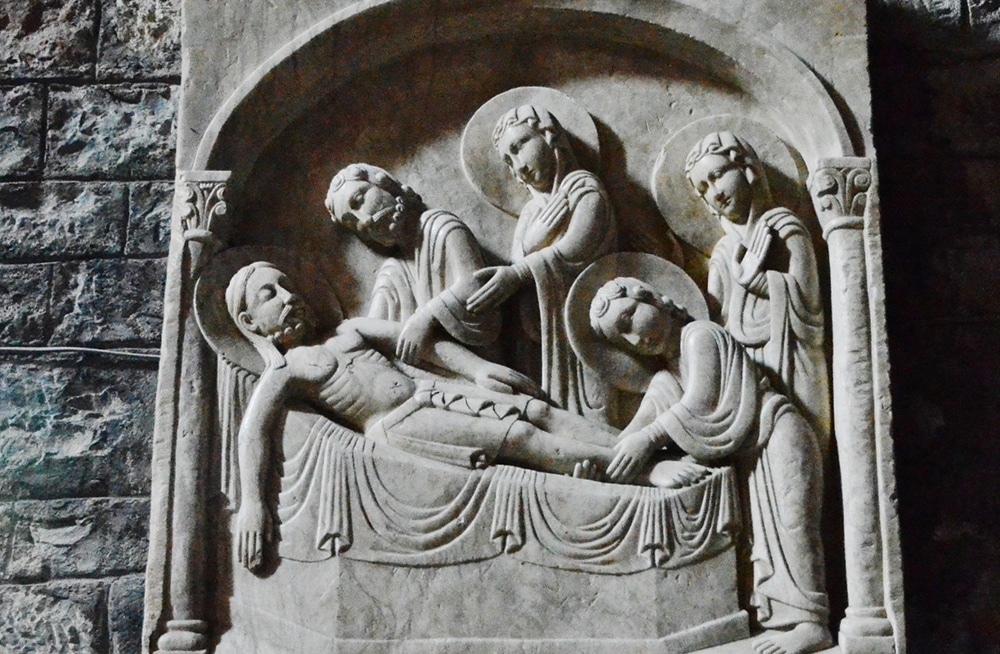
Fourteenth Station: Jesus is laid in the tomb
R. We adore you, O Christ, and we praise you. (Genuflect)
V. Because by your holy cross you have redeemed the world.
“Taking the body, Joseph wrapped it [in] clean linen and laid it in his new tomb that he had hewn in the rock. Then he rolled a huge stone across the entrance to the tomb and departed. But Mary Magdalene and the other Mary remained sitting there, facing the tomb” (Mt 27:59-61).
John gently leads the Virgin Mary away. Mary Magdalen and the other Mary remain. They stay with Jesus.
Were they simply shocked? Unable to believe what they had seen with their own eyes, were they lost in their grief? Were they waiting? Through their tears, could they see glimmers of the extraordinary event to come?
Perhaps they knew they simply needed to be near to Jesus, to be as close to Our Lord as they could manage.
We, too, should remain with him. For our sake he was willing to face even death itself and be hidden in a tomb. Now he hides under the guise of bread. Near him still, let us keep watch and pray.

